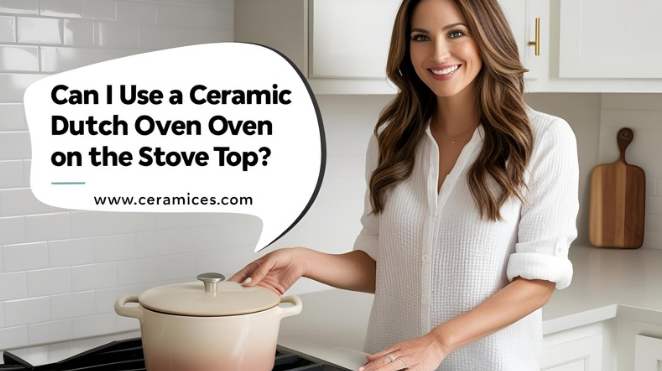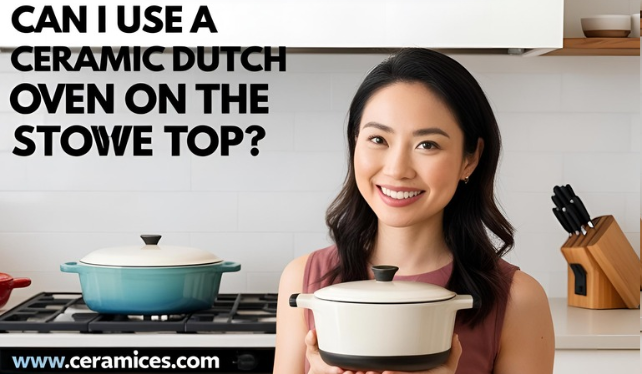Ceramic Dutch ovens are beloved for their versatility, aesthetic appeal, and excellent heat retention. They are a staple in many kitchens, perfect for slow-cooking stews, baking bread, and more. However, a common question that arises is, “Can I use a ceramic Dutch oven on the stove top?” This article will explore the safety, benefits, and limitations of using a ceramic Dutch oven on the stove top, along with tips for proper use and maintenance. Whether you’re a home cook, a baking enthusiast, or simply someone looking to make the most of your cookware, this guide will provide you with all the information you need.
What is a Ceramic Dutch Oven?
A ceramic Dutch oven is a heavy-duty pot with a tight-fitting lid, typically made from ceramic or coated with a ceramic glaze. It is designed for slow cooking, braising, baking, and roasting. Ceramic Dutch ovens are known for their ability to retain heat and distribute it evenly, making them ideal for a variety of cooking methods.
Key Components:
- Ceramic Body: Provides excellent heat retention and even heat distribution.
- Lid: Tight-fitting to trap moisture and heat, enhancing the cooking process.
- Handles: Designed for easy lifting and handling, often heat-resistant.
Can I Use a Ceramic Dutch Oven on the Stove Top?

The short answer is yes, but with some important considerations. Not all ceramic Dutch ovens are created equal, and their suitability for stove top use depends on several factors:
1. Manufacturer Guidelines
Always check the manufacturer’s guidelines to determine if your ceramic Dutch oven is safe for stove top use. Some ceramic Dutch ovens are designed for oven use only.
2. Heat Resistance
Ceramic Dutch ovens must be able to withstand direct heat from a stove top burner. Ensure your Dutch oven is labeled as stove top-safe.
3. Type of Stove Top
Ceramic Dutch ovens can be used on various stove tops, including gas, electric, and induction (if compatible). However, always verify compatibility with your specific stove type.
4. Temperature Limits
Ceramic Dutch ovens have specific temperature limits. Exceeding these limits can cause cracking or damage. Typically, they can handle temperatures up to 500°F (260°C).
5. Avoid Thermal Shock
Ceramic is sensitive to sudden temperature changes. Avoid placing a cold Dutch oven directly on a hot stove top or transferring it from a hot stove top to a cold surface.
Benefits of Using a Ceramic Dutch Oven on the Stove Top
Using a ceramic Dutch oven on the stove top offers several advantages:
1. Versatility
A ceramic Dutch oven can be used for a variety of cooking methods, including boiling, simmering, sautéing, and braising.
2. Even Heat Distribution
Ceramic Dutch ovens distribute heat evenly, ensuring consistent cooking results.
3. Heat Retention
The thick ceramic walls retain heat well, making it ideal for slow-cooking dishes.
4. Aesthetic Appeal
Ceramic Dutch ovens come in a range of colors and designs, adding a touch of style to your kitchen.
5. Non-Reactive Surface
Ceramic is non-reactive, meaning it won’t interact with acidic or alkaline foods, preserving the flavor and quality of your dishes.
Limitations of Using a Ceramic Dutch Oven on the Stove Top
While ceramic Dutch ovens are versatile, there are some limitations to consider:
1. Fragility
Ceramic is more fragile than cast iron or stainless steel. It can crack or chip if dropped or exposed to sudden temperature changes.
2. Weight
Ceramic Dutch ovens are heavy, which can make them difficult to handle, especially when full.
3. Maintenance
Ceramic Dutch ovens require careful handling and maintenance to prevent damage. They should be cleaned gently and stored properly.
4. Cost
High-quality ceramic Dutch ovens can be expensive, although their durability and performance often justify the investment.
Tips for Using a Ceramic Dutch Oven on the Stove Top

To ensure the safe and effective use of a ceramic Dutch oven on the stove top, follow these tips:
1. Check Manufacturer Guidelines
Always verify that your ceramic Dutch oven is stove top-safe by checking the manufacturer’s guidelines.
2. Use Low to Medium Heat
Avoid using high heat, as it can cause the ceramic to crack. Use low to medium heat settings for best results.
3. Preheat Gradually
Preheat the Dutch oven gradually to avoid thermal shock. Place it on a cold burner and then turn on the heat.
4. Avoid Sudden Temperature Changes
Do not transfer a hot Dutch oven directly to a cold surface or immerse it in cold water. Allow it to cool gradually.
5. Use Proper Utensils
Use wooden, silicone, or plastic utensils to avoid scratching the ceramic surface.
6. Monitor Cooking
Keep an eye on your cooking to prevent overheating and ensure even cooking.
7. Clean Gently
Clean the Dutch oven with warm, soapy water and a soft sponge. Avoid using abrasive cleaners or scouring pads.
8. Store Properly
Store the Dutch oven in a cool, dry place. Avoid stacking heavy items on top of it to prevent damage.
Common Uses for a Ceramic Dutch Oven on the Stove Top
A ceramic Dutch oven can be used for a variety of stove top cooking methods, including:
1. Boiling and Simmering
Ideal for making soups, stews, and broths.
2. Sautéing and Frying
Perfect for browning meats, sautéing vegetables, and frying.
3. Braising
Excellent for slow-cooking meats and vegetables in a flavorful liquid.
4. Steaming
Can be used for steaming vegetables, fish, and dumplings.
5. One-Pot Meals
Great for preparing one-pot meals like casseroles, risottos, and pasta dishes.
FAQs: Can I Use a Ceramic Dutch Oven on the Stove Top?
1. Can I use a ceramic Dutch oven on the stove top?
Yes, but always check the manufacturer’s guidelines to ensure it is stove top-safe.
2. What types of stove tops are compatible with ceramic Dutch ovens?
Ceramic Dutch ovens can be used on gas, electric, and induction (if compatible) stove tops.
3. What temperature can a ceramic Dutch oven withstand on the stove top?
Most ceramic Dutch ovens can withstand temperatures up to 500°F (260°C).
4. Can I use high heat on a ceramic Dutch oven?
Avoid using high heat, as it can cause the ceramic to crack. Use low to medium heat settings.
5. How do I prevent thermal shock when using a ceramic Dutch oven on the stove top?
Preheat the Dutch oven gradually and avoid sudden temperature changes.
6. Can I use metal utensils with a ceramic Dutch oven?
It’s best to use wooden, silicone, or plastic utensils to avoid scratching the ceramic surface.
7. How do I clean a ceramic Dutch oven after stove top use?
Clean with warm, soapy water and a soft sponge. Avoid abrasive cleaners or scouring pads.
8. Can I use a ceramic Dutch oven on an induction stove top?
Only if the Dutch oven is compatible with induction. Check the manufacturer’s guidelines.
9. What should I do if my ceramic Dutch oven cracks on the stove top?
Discard the cracked Dutch oven immediately to prevent injury or further damage.
10. Are ceramic Dutch ovens heavy?
Yes, ceramic Dutch ovens are heavy, which can make them difficult to handle, especially when full.
Conclusion: Can I Use a Ceramic Dutch Oven on the Stove Top?
Yes, you can use a ceramic Dutch oven on the stove top, provided it is labeled as stove top-safe and used within its temperature limits. By following best practices such as using low to medium heat, preheating gradually, and avoiding sudden temperature changes, you can safely and effectively use a ceramic Dutch oven on the stove top.
So, the next time you ask, “Can I use a ceramic Dutch oven on the stove top?” remember that with the right precautions and high-quality cookware, you can enjoy the versatility and performance of a ceramic Dutch oven in your cooking. Whether you’re boiling, simmering, sautéing, or braising, a ceramic Dutch oven offers a durable and stylish solution for all your stove top needs. By making informed decisions and following proper care guidelines, you can extend the lifespan of your ceramic Dutch oven and enjoy its benefits for years to come.
Read more
1 Can Ceramic Go in the Oven? A Guide to Using Ceramic in the Oven